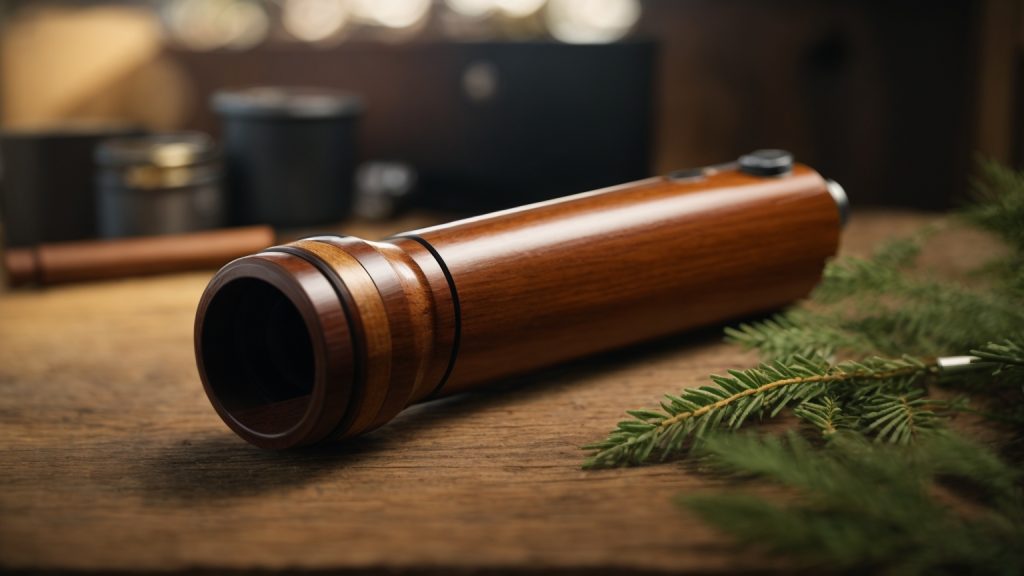Are you interested in making your own wooden whistle? It’s a fun and simple woodworking project that can be completed in just a few minutes. With the right tools and materials, you can create a unique and functional whistle that you can use or gift to others.
There are many different ways to make a wooden whistle, and the process can vary depending on the design you choose. Some people prefer to use hand tools, while others may opt for power tools to speed up the process. Regardless of your approach, the basic steps for making a wooden whistle include selecting the right wood, drilling a hole through the center, and shaping the whistle to produce sound.
Whether you are a seasoned woodworker or a beginner looking for a new project, making a wooden whistle is a great way to hone your skills and create something useful and beautiful. So, grab your tools and let’s get started!
Understanding Wood Types

When it comes to making a wooden whistle, understanding the types of wood available is important. Different woods have different properties, and choosing the right one can make all the difference in the sound quality and durability of your whistle.
Hardwood
Hardwood is a dense and durable type of wood that is often used in woodworking projects. It is a popular choice for making wooden whistles because it produces a clear and distinct sound. Some common types of hardwood include:
- Oak
- Maple
- Cherry
- Walnut
- Mahogany
Each of these woods has its own unique properties. Oak, for example, is a strong and sturdy wood that is often used for furniture. Maple is a hard and dense wood that is ideal for making musical instruments. Cherry has a warm and rich tone, while walnut is known for its deep and rich color.
Softwood
Softwood, as the name suggests, is a softer and less dense type of wood. It is often used in construction and woodworking projects because it is easy to work with and readily available. However, it is not always the best choice for making wooden whistles because it can produce a muffled or unclear sound. Some common types of softwood include:
If you do choose to use softwood for your whistle, it is important to choose a high-quality piece of wood that is free of knots and other imperfections. This will help to ensure that your whistle produces a clear and distinct sound.
In general, it is best to choose a hardwood for making a wooden whistle. However, if you do decide to use softwood, be sure to choose a high-quality piece of wood and take extra care when carving and shaping it to ensure that it produces a clear and distinct sound.
Tools Needed
When it comes to making a wooden whistle, having the right tools is essential. In this section, we’ll go over the tools you’ll need to create your own beautiful and functional wooden whistle.
Carving Tools
To create the shape of your whistle, you’ll need some carving tools. Here are some of the essential carving tools you’ll need:
- A carving knife – for roughing out the shape of the whistle
- A gouge – for carving out the hollow portion of the whistle
- A chisel – for creating the air channel in the whistle
Sanding Tools
Once you’ve carved the shape of your whistle, you’ll need to sand it down to create a smooth finish. Here are some sanding tools you’ll need:
- Sandpaper – choose a variety of grits to get the right finish
- Sanding block – to hold the sandpaper and create a flat surface for sanding
- Dremel tool – for sanding hard-to-reach areas
Finishing Tools
To protect and enhance the beauty of your wooden whistle, you’ll need to apply a finish. Here are some of the finishing tools you’ll need:
- Wax – to protect the wood and give it a nice shine
- Varnish – for a more durable finish
- Paint – if you want to add some color to your whistle
In conclusion, having the right tools is crucial to making a wooden whistle that looks and sounds great. By investing in the right carving, sanding, and finishing tools, you’ll be able to create a beautiful and functional whistle that you can be proud of.
Choosing the Right Wood
When it comes to making a wooden whistle, choosing the right type of wood is essential. Not all woods are created equal, and some will produce better results than others. Here are some things to consider when selecting the wood for your whistle:
Hardness
The hardness of the wood will affect the sound quality of your whistle. Softer woods, such as pine or cedar, will produce a softer, more mellow sound. Harder woods, such as oak or maple, will produce a louder, more piercing sound. Consider the sound you want your whistle to produce when choosing the wood.
Grain Direction
The direction of the wood grain can also affect the sound quality of your whistle. For the best results, choose a piece of wood with straight, even grain running parallel to the length of the whistle. This will allow the air to flow smoothly through the whistle, producing a clear, consistent sound.
Density
The density of the wood will also affect the sound quality of your whistle. A denser wood will produce a louder, clearer sound than a less dense wood. However, denser woods can be more difficult to work with, so consider your skill level and the tools you have available before choosing a dense wood.
Common Woods for Whistle Making
Here are some common woods used for making whistles, along with their characteristics:
| Wood Type | Characteristics |
|---|---|
| Cherry | Medium hardness, good tone |
| Maple | Hard, bright tone |
| Oak | Hard, loud tone |
| Walnut | Medium hardness, warm tone |
| Cedar | Soft, mellow tone |
| Pine | Soft, mellow tone |
In general, hardwoods will produce a better sound than softwoods. However, softer woods can be easier to work with, especially for beginners. Ultimately, the best wood for your whistle will depend on your personal preferences and skill level.
Designing Your Whistle

When it comes to designing your wooden whistle, there are a few things to keep in mind. First, you’ll want to consider the size and shape of your whistle. The size will determine the pitch of the sound, while the shape will affect the quality and volume of the sound.
Next, you’ll want to think about the placement of the finger holes. These holes will determine the notes that can be played on the whistle. You may want to experiment with different hole sizes and placements to achieve the desired sound.
Another factor to consider is the type of wood you’ll be using. Different types of wood can produce different sounds, so it’s important to choose a wood that will complement the sound you’re looking to achieve. Hardwoods like maple, oak, and cherry are good options for wooden whistles.
You may also want to add decorative elements to your whistle, such as carving or wood burning. These can add a personal touch and make your whistle unique.
Overall, designing your wooden whistle can be a fun and creative process. By considering the size, shape, finger hole placement, wood type, and decorative elements, you can create a whistle that produces the sound and look you desire.
Carving the Whistle
Carving the whistle is the most important part of the process. This is where you will shape and create the sound of the whistle. In this section, we will discuss how to shape the body and create the mouthpiece.
Shaping the Body
To shape the body of the whistle, you will need a woodblock that is soft enough for carving, a knife or ax (or both), and a carving and finishing tool (sander or sandpaper) to smooth edges and round the whistle once finished.
- First, draw the shape of the whistle on the woodblock using a pencil. Make sure to leave enough room for the mouthpiece and the sound hole.
- Use the knife or ax to carve the woodblock into the shape of the whistle. Be careful not to carve too much, as this can affect the sound of the whistle.
- Once you have the basic shape, use the carving and finishing tool to smooth the edges and round the whistle. This will help to create a better sound.
Creating the Mouthpiece
The mouthpiece is the most important part of the whistle, as it is where the sound is created. To create the mouthpiece, you will need a vice to help hold the wood in place, but it can be omitted if you’re careful.
- Clamp the woodblock in the vice, making sure that the part you want to carve is facing up.
- Using the knife or carving tool, carve a small hole in the top of the whistle to create the mouthpiece. Make sure the hole is small enough to create a high-pitched sound.
- Once you have created the hole, use the carving and finishing tool to smooth the edges and round the mouthpiece. This will help to create a better sound.
Remember, the key to creating a good whistle is to take your time and be patient. Don’t rush the process, and make sure to test the whistle frequently as you carve it. With a little practice, you’ll be able to create a beautiful and functional whistle that you can be proud of.
Creating the Sound Hole
The sound hole is a crucial part of your wooden whistle, as it is what produces the sound when you blow into the whistle. Here’s how you can create the sound hole:
- Determine the placement: Before you start drilling, you need to decide where you want your sound hole to be. Typically, the sound hole is located about 1/3 of the way down the whistle, but you can experiment with different placements to achieve different sounds.
- Mark the spot: Once you have determined the placement, use a pencil to mark the spot where you want to drill the sound hole.
- Drill the hole: Using a drill bit that is slightly smaller than the diameter of your whistle, drill a hole straight through the whistle at the marked spot. Be sure to drill all the way through the whistle.
- Create the escapement: The escapement is a small notch that you will create on the underside of the sound hole. This allows air to escape and produce the sound. To create the escapement, use a small file to carefully carve a small notch on the underside of the sound hole.
- Test the sound: Once you have created the sound hole and escapement, test the sound of your whistle by blowing into it. If the sound is not quite right, you can experiment with the size and shape of the sound hole to achieve the desired sound.
Remember to be patient and take your time when creating the sound hole, as it is a crucial part of your wooden whistle. With a little practice and experimentation, you’ll be able to create a beautiful and unique sound that is all your own.
Sanding the Whistle
Now that you have created your wooden whistle, it’s time to sand it down to give it a smooth and polished finish. Sanding the whistle will also help to remove any rough edges or splinters that may have been left behind during the carving process.
To begin sanding, you will need a few supplies, including sandpaper, a sanding block, and a soft cloth. Start by wrapping a piece of sandpaper around the sanding block and gently rubbing it over the surface of the whistle. Be sure to sand evenly and in the direction of the grain of the wood.
As you sand, you may notice that the surface of the whistle becomes smoother and more polished. If you find that there are still rough spots or areas that need further sanding, switch to a finer grit sandpaper and continue sanding until the surface is smooth and even.
Once you have finished sanding, use a soft cloth to wipe away any dust or debris that has accumulated on the surface of the whistle. You may also want to apply a coat of wood polish or wax to help protect the surface of the wood and give it a shiny finish.
Overall, sanding your wooden whistle is an important step in the process of creating a beautiful and functional instrument. With a little bit of time and effort, you can create a whistle that looks and sounds great.
Applying the Finish
Once your wooden whistle is complete, it’s time to apply the finish. This step is important as it helps to protect the wood and gives it a polished look. Here’s how to apply the finish:
- Sand the whistle: Before applying any finish, sand the whistle with fine-grit sandpaper to remove any rough spots or imperfections. Make sure to sand the whistle evenly to avoid any uneven finish.
- Choose your finish: There are many types of finishes you can use, such as paint, stain, or varnish. Each finish has its own advantages and disadvantages, so choose the one that best suits your needs. For example, if you want a natural look, use a clear varnish. If you want a colorful whistle, use paint.
- Apply the finish: Apply the finish using a brush, sponge, or cloth. Make sure to apply the finish evenly and follow the manufacturer’s instructions. If you’re using a varnish or stain, apply a thin layer and let it dry before applying another layer. If you’re using paint, apply two or three coats, letting each coat dry before applying the next.
- Let it dry: Once you’ve applied the finish, let the whistle dry completely. This can take several hours or even overnight, depending on the type of finish you used. Make sure to let the whistle dry in a well-ventilated area.
- Sand again: After the finish has dried, sand the whistle lightly with fine-grit sandpaper to remove any bumps or rough spots. This will give the whistle a smooth and polished look.
- Enjoy your whistle: Once the finish has dried and you’ve sanded the whistle, it’s ready to use. Blow into it and enjoy the sound of your handmade wooden whistle.
Remember, applying the finish is an important step in making a wooden whistle. It not only protects the wood but also gives it a polished look. Follow these steps, and you’ll have a beautiful and functional wooden whistle that you can be proud of.
Testing the Whistle
Once you have finished making your wooden whistle, it’s time to test it out and see how it sounds. Here are some tips to help you test your whistle:
1. Blow Gently
When testing your whistle, it’s important to blow gently at first. This will help you get a feel for the whistle and how it sounds. You can gradually increase the force of your breath to see how the sound changes.
2. Adjust the Airflow
The sound of your whistle can be affected by the amount of airflow that passes through it. You can adjust the airflow by moving your tongue and lips around the whistle’s mouthpiece. Experiment with different positions to see how it affects the sound.
3. Check for Cracks or Leaks
Before testing your whistle, make sure to inspect it for any cracks or leaks. If there are any, the sound may be affected. You can use a small amount of wood glue or wax to seal any cracks or leaks.
4. Compare with Other Whistles
To get a better sense of how your whistle sounds, you can compare it with other whistles. Try testing it alongside a store-bought whistle or another handmade whistle. This can help you identify any areas where your whistle may need improvement.
5. Practice Makes Perfect
Remember, making a wooden whistle takes practice. Don’t be discouraged if your first attempt doesn’t sound perfect. Keep practicing and experimenting with different techniques until you find the sound you’re looking for.
By following these tips, you’ll be able to test your wooden whistle and make any necessary adjustments to get the perfect sound. Enjoy the process and have fun making music with your handmade whistle!
